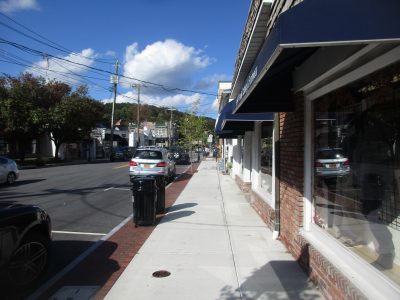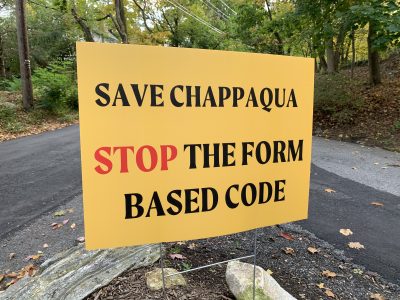Form Based Code Would Produce Modestly Higher Enrollment Hike in Chappaqua Schools

Chappaqua Central School District consultants revealed last week that the proposed Form Based Code’s full build-out scenario would produce 36 more students than had been estimated by the Town of New Castle’s experts.
In a report compiled by the engineering and planning firms The Chazen Companies and Econsult Solutions, Inc., the construction of 997 one- and two-bedroom apartments in the 72-acre study area in downtown Chappaqua would generate 150 additional students in the seven years from 2023 to 2030. Meanwhile, the town’s consultants have placed that number at 114 children over a 15-year span in the code’s Draft Generic Environmental Impact Statement (DGEIS).
The difference is a result of the methods used to compute the number of school-age children for different types of housing in various communities. The Chazen Companies employed the Public Use Microdata Sample, which uses a higher multiplier for two-bedroom apartments in multifamily structures than the Rutgers University Center for Urban Policy Research Center, the method that the town’s consultants based their estimates on. The Rutgers formula was devised about 15 years ago based on information in the 2000 Census.
New Castle Supervisor Ivy Pool said last week that she and her board colleagues were still digesting the heavy volume of information in the school district’s consultants’ report presented last Wednesday evening, but there doesn’t appear to be a significant difference between the two studies.
“What they told us is certainly a higher projection but not of the magnitude that some in the community had feared,” Pool said.
She also noted that the town used 15 years for full build-out while the seven-year estimate for full build-out is unrealistic.
The Town Board is expected to discuss the school district’s report in more detail and other issues related to the DGEIS during Tuesday night’s work session. Continuation of the public hearing on the DGEIS will follow.

Since the start of the hearings in October, some residents and school district officials feared that the town’s projection of additional schoolchildren with the introduction of mixed-use development downtown was seriously underestimated. Concerns have been repeatedly raised that the influx of students could flood Chappaqua schools and potentially trigger capacity issues in the schools, higher budgets and higher property taxes.
However, town officials have countered that the Form Based Code is not a development plan but a zoning revision designed to eventually attract developers to propose mixed-use projects to enliven the downtown and help diversify the town’s housing stock. The full build-out scenario is unlikely ever to occur, they have argued, because it would require the sale of multiple town-owned properties, each subject to a permissive referendum, and coordination between private property owners.
A full build-out projection is required of the town under the state Environmental Quality Review Act. (SEQRA).
Econsult Solutions Director Frank Robinson said the extra 36 children would increase the school district budget by about $8 million regardless of future birthrates. For the purpose of calculations, the consultants used three estimates for future birthrates within the Chappaqua School District: a yearly average for the decade of the 2000s, another for the 2010s and an average of those two decades.
In the 2000s, according to the report, there was a 10-year average of 160 children born in the zip codes comprising the district. The 2010s saw a sharp decline to a 110-child annual average while the average between the two decades stands at 135.
The live birthrate in the district in 2020 increased to 120, said Erik Kaeyer, from the Mount Kisco architectural firm KG&D.
“Is that a one-year blip or is that the beginning of a new trend?” Kaeyer said.
There doesn’t appear there will be a districtwide capacity issue based on the 110 and 135 annual birthrate scenarios because “the existing housing stock has accommodated a larger population in the past,” he said.
Current district enrollment stands at 3,556 students, down nearly 700 from the district’s all-time peak of 4,254 in 2007-08, Kaeyer said. In that time, elementary school enrollment has declined about 30 percent, the middle schools are down 20 percent and the high school is off by 15 percent.
However, Kaeyer mentioned that there could be capacity issues at individual schools, most notably Douglas Grafflin Elementary School and Robert E. Bell Middle School, based on the existing zoning. Another 30 students are projected for the Chappaqua Crossing townhouses, the mixed-used development at 91 Bedford Rd. and the Conifer affordable housing project on Hunts Place, all of which would feed into Grafflin and Bell.
Kaeyer said that the functional capacity, described as 85 percent of maximum capacity, at the three elementary schools is 521 students each, while Seven Bridges Middle School has a functional capacity of 774 students compared with Bell, which is 701.
He does not expect Horace Greeley High School to have a capacity issue.
Deputy Supervisor Jeremy Saland said at last week’s joint meeting that the Form Based Code appears to be less of an influence in future enrollment projections than other factors.
“It’s really not a hamlet issue, it’s really something the district should be examining irrespective of this, or maybe it’s a catalyst for the district to examine this,” Saland said. “But it’s a districtwide issue irrespective of the 114 or 150 (students) in the worst-case scenario.”
Board of Education President Victoria Tipp said district and town officials should also explore the makeup of the number of bedrooms and how that could affect the schools. Under the full build-out scenario, the DGEIS uses 599 one-bedroom and 299 two-bedroom market-rate units. There would also be 99 affordable units – 66 with one bedroom and 33 with two bedrooms.
The effects of COVID-19 on future trends should also be further studied, she said.
Tipp said the school board authorizing the study was for planning purposes, not to appear to exclude students from the district.
“I just want to be clear what our purpose here is; (it’s) not to prevent kids from coming into the district, it is to understand how many will move in so that everyone can plan adequately,” Tipp said.
It is likely that the public hearing on the DGEIS will be closed Tuesday night, Pool said, to allow for the town’s consultants to address the long list of issues raised the past three months. A 30-day written comment period will remain open.

Martin has more than 30 years experience covering local news in Westchester and Putnam counties, including a frequent focus on zoning and planning issues. He has been editor-in-chief of The Examiner since its inception in 2007. Read more from Martin’s editor-author bio here. Read Martin’s archived work here: https://www.theexaminernews.com/author/martin-wilbur2007/
